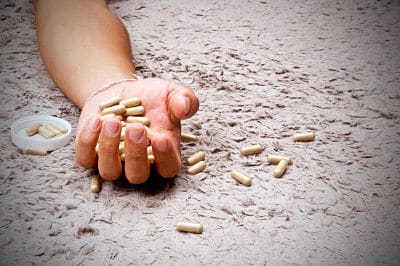
One of the most memorable scenes in Quentin Tarantino’s Pulp Fiction is when Mia Wallace (Uma Thurman) overdoses on heroin, thinking it was cocaine, and is saved by an emergency shot of adrenaline into her heart.
That likely wouldn’t work in real life, but there is a medication that might: naloxone, an opioid antagonist that blocks the effect of opioids. It is injected into a thigh muscle or sprayed into the nostril, almost instantly reversing the overdose, if the person overdosing hasn’t already died. (If the heart has stopped, a shot of adrenaline – in the form of epinephrine – might help, but only if also injected into the thigh, not the heart.)
More than 165,000 people in the U.S. died of opioid pain medication-related overdoses between 1999 and 2014, according to the Centers for Disease Control and Prevention, and not all were junkies seeking a bigger high. Many were people with chronic pain and legitimate prescriptions who accidentally took too large a dose, or took it in conjunction with a glass of wine, other drugs or a medical condition that increased the effect of drug.
Since 2014 the Substance Abuse and Mental Health Services Administration (SAMHSA) has published the Opioid Overdose Prevention Toolkit and Expansion of Naloxone in the Prevention of Opioid Overdose, advocating that laws and regulations be changed so that first responders can expand their use of naloxone in emergency situations. In some places, naloxone prescriptions for addicts and families of addicts already are available, and have reduced the number of deaths by heroin overdose significantly.
Even some conservative Republicans – including Newt Gingrich – want increased treatment options, including naloxone, for people prescribed an opioid painkiller. They recognize the scale of the epidemic and the need to treat dependency non-moralistically like any other chronic illness.
Now a study by San Francisco public health officials recommends that every prescription for opioid prescription medications be accompanied by a prescription for a dose of naloxone in case of a “bad reaction.”
A moralistic concern that the easy availability of an antidote might encourage reckless drug abuse is not borne out by the study. In fact, the opposite appears to occur. When people are made more aware of the risks of taking the drug, they’re more careful and don’t end up in emergency rooms as often.
Naloxone is available as a single-use injection (Evzio), a nasal spray (Narcan) and also can be prescribed in an under-the-tongue tablet of film (Suboxone) combined with buprenorphine for weaning an addict off opioids without withdrawal. The buprenorphine delivers a smaller dose of opioids – it’s not enough for an opioid addict to get high, if taken as prescribed – and the naloxone has no effect. But if the tablet is dissolved for intravenous injection, the naloxone is activated, negating the effect of the buprenorphine and causing instant withdrawal pains.
Currently naloxone is available without a prescription in at least 14 states, including Arkansas, Massachusetts, Minnesota, Mississippi, Montana, New Jersey, North Dakota, Pennsylvania, Rhode Island, South Carolina, Tennessee and Utah, as well as rehabs in California.
Although advocates feel naloxone should be available without a prescription, emergency medical care is strongly advised soon after use. Sometimes one dose of naloxone is not enough, as opioids can remain in the system hours longer than the antagonist.
Simone Flynn blogs about addiction, recovery, mental health, and wellness. Check out her blog and Twitter.


